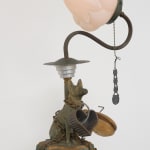Jess (Collins) American, 1923-2004
Assembly Lamp Seven, 1963
mixed media assemblage
29 x 18 x 18 in
73.7 x 45.7 x 45.7 cm
73.7 x 45.7 x 45.7 cm
Further images
-
(View a larger image of thumbnail 1
)

-
(View a larger image of thumbnail 2
)

-
(View a larger image of thumbnail 3
)

-
(View a larger image of thumbnail 4
)

-
(View a larger image of thumbnail 5
)

-
(View a larger image of thumbnail 6
)

-
(View a larger image of thumbnail 7
)

-
(View a larger image of thumbnail 8
)

As Jess forged a new a life of creative, intellectual, and social freedom in San Francisco during the 1960s, his art-making spilled over into home-making. Jess and and his partner,...
As Jess forged a new a life of creative, intellectual, and social freedom in San Francisco during the 1960s, his art-making spilled over into home-making. Jess and and his partner, Robert Duncan, embraced their domestic sphere and through it forged a tight-knit community of artists, poets, and musicians with open interpretations of what art could be and a radical conception of what art could be.
Central to Jess's practice — for conceptual, as well as financial, reasons — was the practice of scavenging for the raw materials of art making. By re-claiming objects, images, and language, then re-assessing, re-arranging, and re-contextualizing them, Jess alchemically transformed everyday detritus and hidden treasures into talismanic objects, loaded with potential meaning and humor.
Jess's lamps exemplify this relationship between necessity, invention, and creativity. Stylistically, these works often had a sense of fracture and repair… of a shattered world order, re-assembled to reveal long-hidden truths. Lived with and loved by Jess and Duncan, Assembly Lamp Seven (1963) is one of 10 existing lamps Jess made for friends and for his personal use. At the base of the work, an interlocking chain embraces together a heart, a shell, a loyal dog muzzled with a thimble, and an assortment of found treasures. The work is full of references to the past, to Victorian sensibilities, but full of modernist irony and deeply human, forged with humor and care.
Central to Jess's practice — for conceptual, as well as financial, reasons — was the practice of scavenging for the raw materials of art making. By re-claiming objects, images, and language, then re-assessing, re-arranging, and re-contextualizing them, Jess alchemically transformed everyday detritus and hidden treasures into talismanic objects, loaded with potential meaning and humor.
Jess's lamps exemplify this relationship between necessity, invention, and creativity. Stylistically, these works often had a sense of fracture and repair… of a shattered world order, re-assembled to reveal long-hidden truths. Lived with and loved by Jess and Duncan, Assembly Lamp Seven (1963) is one of 10 existing lamps Jess made for friends and for his personal use. At the base of the work, an interlocking chain embraces together a heart, a shell, a loyal dog muzzled with a thimble, and an assortment of found treasures. The work is full of references to the past, to Victorian sensibilities, but full of modernist irony and deeply human, forged with humor and care.
Exhibitions
San Francisco, CA, Hosfelt Gallery, BRUCE CONNER + JESS: THE VIRTUE OF UNCERTAINTY, 5 September - 14 October 2023
Your shopping bag
This purchase may be subject to local rates of import, sales and use taxes for which the purchaser is 100% liable.
No items found
Close
Your Favorites
Create a list of works then send us an inquiry.
No items found







